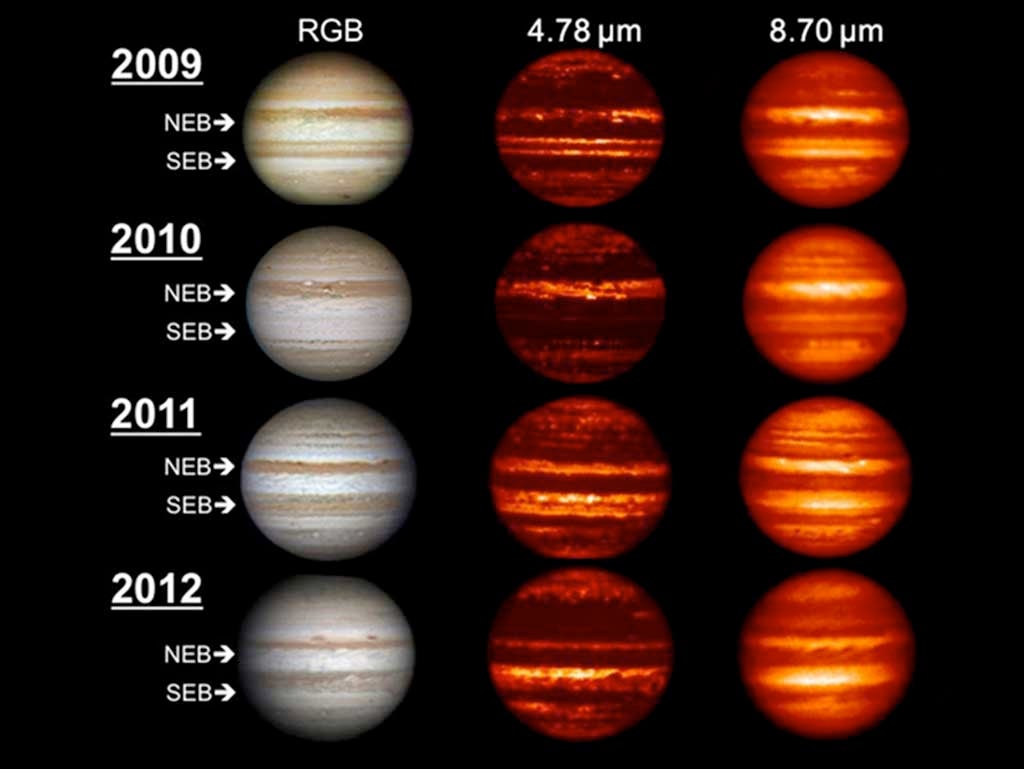“The changes we’re seeing in Jupiter are global in scale,” said Glenn Orton from NASA’s Jet Propulsion Laboratory in Pasadena, California. “We’ve seen some of these before, but never with modern instrumentation to clue us in on what’s going on. Other changes haven’t been seen in decades, and some regions have never been in the state they’re appearing in now. At the same time, we’ve never seen so many things striking Jupiter. Right now, we’re trying to figure out why this is all happening.”
Orton and colleagues have been taking images and maps of Jupiter at infrared wavelengths from 2009 to 2012 and comparing them with high-quality visible images from the increasingly active amateur astronomy community. Following the fading and return of a prominent brown-colored belt just south of the equator, called the South Equatorial Belt, from 2009 to 2011, the team studied a similar fading and darkening that occurred at a band just north of the equator, known as the North Equatorial Belt. This belt grew whiter in 2011 to an extent not seen in more than a century. In March of this year, that northern band started to darken again.
The team obtained new data from NASA’s Infrared Telescope Facility and the Subaru Telescope on Mauna Kea that matched up with infrared observations. Those data showed a simultaneous thickening of the deeper cloud decks, but not necessarily the upper cloud deck, unlike the South Equatorial Belt, where both levels of clouds thickened and then cleared up. The infrared data also resolved brown, elongated features in the whitened area called “brown barges” as distinct features and revealed them to be regions clearer of clouds and probably characterized by downwelling, dry air.
The team was also looking out for a series of blue-gray features along the southern edge of the North Equatorial Belt. Those features appear to be the clearest and driest regions on the planet and show up as apparent hotspots in the infrared view because they reveal the radiation emerging from a deep layer of Jupiter’s atmosphere. (NASA’s Galileo spacecraft sent a probe into one of these hotspots in 1995.) Those hotspots disappeared from 2010 to 2011, but they had reestablished themselves by June of this year, coincident with the whitening and re-darkening of the North Equatorial Belt.
While Jupiter’s atmosphere has been churning through change, a number of objects have hurtled into it, creating fireballs visible to amateur Jupiter watchers on Earth. Three of these objects, probably less than 45 feet (15 meters) in diameter, have been observed since 2010. The latest of these hit Jupiter on September 10, 2012, although Orton and colleagues’ infrared investigations of these events showed this one did not cause lasting changes in the atmosphere, unlike those in 1994 or 2009.
“It does appear that Jupiter is taking an unusual beating over the last few years, but we expect that this apparent increase has more to do with an increasing cadre of skilled amateur astronomers training their telescopes on Jupiter and helping scientists keep a closer eye on our biggest planet,” Orton said. “It is precisely this coordination between the amateur-astronomy community that we want to foster.”










